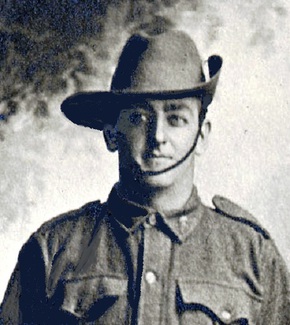
MS5884
ROBERTS, William Henry
| Service Number: | 165 |
|---|---|
| Enlisted: | 11 January 1916 |
| Last Rank: | Private |
| Last Unit: | 43rd Infantry Battalion |
| Born: | Payneham, South Australia, date not yet discovered |
| Home Town: | Norwood (SA), South Australia |
| Schooling: | Not yet discovered |
| Occupation: | Blacksmith Striker |
| Memorials: |
World War 1 Service
| 11 Jan 1916: | Enlisted Australian Army (Post WW2), Private, 165, 43rd Infantry Battalion | |
|---|---|---|
| 9 Jun 1916: | Involvement Private, 165, 43rd Infantry Battalion, --- :embarkation_roll: roll_number: '18' embarkation_place: Adelaide embarkation_ship: HMAT Afric embarkation_ship_number: A19 public_note: '' | |
| 9 Jun 1916: | Embarked Private, 165, 43rd Infantry Battalion, HMAT Afric, Adelaide | |
| Date unknown: | Wounded 165, 43rd Infantry Battalion |
Help us honour William Henry Roberts's service by contributing information, stories, and images so that they can be preserved for future generations.
Add my storyBiography contributed by St Ignatius' College
William Henry Roberts was a soldier in World War I who was born in Payneham, South Australia in 1894. He lived on 43 King Street Norwood, worked as a blacksmith and never married. His mother was Judith Roberts. William Henry Roberts enlisted on the 11th of January 1916 and embarked to fight in World War I at the age of 22, on the 9th of June on the HMAT A19 Afric battleship. His unit, according to the nominal roll was the 43rd battalion and he was ranked as a private. William Henry Roberts was 5 feet 6 and 3 quarters tall which is 169.545 centimetres, and he weighed 148 pounds which is 67 kilograms.
Shortly before embarking overseas, William Henry Roberts trained at Morphettville Camp. The 43rd battalion began in June 1916, after landing in Egypt and then went on to Britain for further training in July 1916, and this is where its soldiers suffered from a mumps epidemic, which is an infection. The battles that William Henry Roberts was involved in included, the battle of Messines and the third battle of Ypres. The battle of Messines went on for a week from June the 7th 1917 to June the 14th 1917. The task of this battle was to force the German enemy to withdraw from the main battlefront of Vimy Arras. The battle exemplified tactical success through careful planning and overwhelming firepower.
During the war, the men of the 43rd battalion, including William Henry Roberts, carried a bolt action rifle called the British Lee-Enfield and a Lewis gun. Field Marshal Sir Douglas Haig, the British commander-in-chief, planned an attack to drive the Germans from the surrounding dominant ridges and even hoped to reach the Belgian coast. The chief released his great attack on July the 31st 1917. Unfortunately for William Henry Roberts, he was wounded in action on the field on the 31st of July 1917, in the third battle of Ypres. William Henry Roberts suffered a GSW, meaning that he got a shrapnel wound, which was to the head and to the left part of the shoulder. He left for England to have his wound treated on the 14th of August 1917. Shortly after he was wounded, his mother received written notification that he had been injured but that he was recovering well, in the Reading War Hospital.
William Henry Roberts attended another hospital in France on the 10th of May 1918 because of influenza. Shortly later he returned to Australia on the 15th of January 1919. His total service for the war was 3 years and 111 days and for his service abroad, it was 2 years and 265 days. The reason for his discharge was because he was medically unfit (not due to misconduct).
At the end of the war, William Henry Roberts received a few medals, including the silver British war medal and a victory medal. The silver British war medal was awarded to 6.5 million soldiers across the United Kingdom and the Australian Imperial force, and was given to soldiers in between the dates of 1918-1918. The victory medal was commemorated for the victory of the allied forces over the central powers, this was also given to soldiers during 1914-1918.
The ANZAC spirit played a big part in World War 1. ANZAC stands for Australian New Zealand Army Corps. The ANZAC spirit is a concept which suggests that Australian and New Zealand soldiers possess shared characteristics and the qualities that the soldiers showed on the battlefields, mainly in World War 1. These characteristics and qualities included, endurance which means that you never stop you keep going, courage coming into Word War 1 with no fear, good humour to be able to have a laugh with people, mate ship, to be able to work together on the battlefields and outside and ingenuity, the quality to be creative, clever and original.
William Henry Roberts exemplified the ANZAC spirit in that he had the courage and bravery to enlist for World War 1, and to fight for his country. He also shows the ANZAC spirit given he demonstrated endurance to continue to fight in the war, despite being injured and becoming unwell.
















